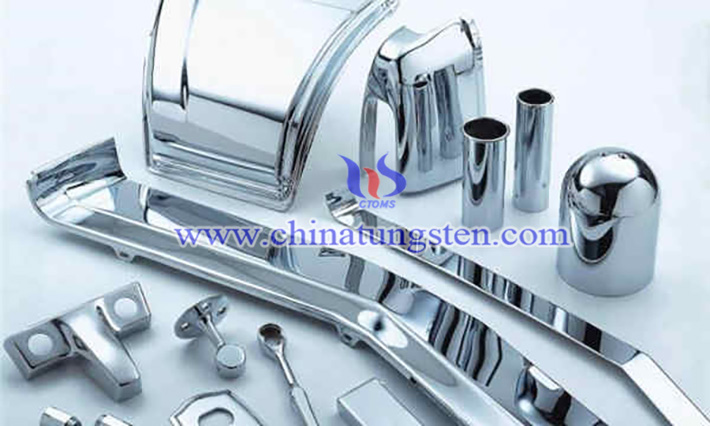Nickel-Tungsten Alloy Coatings to Substitute Chrome Coatings
- Details
- Category: Tungsten Information
- Published on Tuesday, 28 March 2023 21:53

A team of Indian scientists have developed a new method of deposition of Nickel-Tungsten alloy coatings on high-performance materials in engineering applications can replace environmentally toxic chrome coatings. The coatings obtained are also highly corrosion-resistant and useful for the plastic ware industry.
How Is Ammonium Metatungstate Synthesized?
- Details
- Category: Tungsten Information
- Published on Wednesday, 01 March 2023 17:41
.jpg)
Ammonium metatungstate (AMT) can be synthesized by reacting sodium tungstate with ammonium chloride in aqueous solution, followed by acidification with hydrochloric acid. The reaction can be summarized by the following equation:
How Is Ammonium Metatungstate Stored And Handled?
- Details
- Category: Tungsten Information
- Published on Wednesday, 01 March 2023 17:39

Ammonium metatungstate (AMT) is a white crystalline powder that is used in the production of tungsten metal, tungsten carbide, and other tungsten compounds. It is a stable compound under normal conditions, but it can decompose at high temperatures or in contact with strong acids or oxidizing agents.
Here are some guidelines for the safe storage and handling of ammonium metatungstate:

Storage: AMT should be stored in a cool, dry, well-ventilated area away from incompatible materials such as strong acids, oxidizing agents, and combustible materials. The storage area should be clearly labeled and access should be restricted to authorized personnel only.
Handling: When handling AMT, wear appropriate personal protective equipment such as gloves, goggles, and a lab coat. Avoid direct contact with skin, eyes, and clothing. AMT should be handled in a fume hood to prevent inhalation of the powder. Use a dust mask or respirator if necessary.
Transportation: AMT should be transported in a sealed, unbreakable container to prevent accidental spills or leaks. The container should be labeled with the name of the chemical, the hazard warnings, and the name of the supplier.
Disposal: AMT should be disposed of according to local, state, and federal regulations. It should not be disposed of in regular trash or poured down the drain. Contact your local hazardous waste disposal facility for instructions on proper disposal.
In summary, ammonium metatungstate should be stored in a cool, dry, well-ventilated area away from incompatible materials, handled with appropriate personal protective equipment, transported in a sealed, unbreakable container, and disposed of according to local regulations.
- AMT Manufacturer & Supplier, Chinatungsten Online: ammonium-metatungstate.com
- Tungsten News & Prices of China Tungsten Industry Association: www.ctia.com.cn
- Molybdenum News & Price: news.molybdenum.com.cn
- Tel.: 86 592 5129696; Fax: 86 592 5129797; Email: sales@chinatungsten.com
Is Ammonium Metatungstate Toxic or Hazardous to Human Health or the Environment?
- Details
- Category: Tungsten Information
- Published on Wednesday, 01 March 2023 17:38

Ammonium metatungstate (AMT) is a white crystalline powder that is used as a precursor to make tungsten metal and tungsten alloys, as well as a catalyst and a pigment in various industrial applications.
Ammonium Metatungstate Price
- Details
- Category: Tungsten Information
- Published on Wednesday, 01 March 2023 17:36

The price of ammonium metatungstate (AMT) can vary depending on several factors such as the quality, quantity, purity, and supplier.
Ammonium Metatungstate in Thermal Insulating
- Details
- Category: Tungsten Information
- Published on Wednesday, 01 March 2023 17:34
.jpg)
Ammonium metatungstate (AMT) can be used as a thermal insulating material due to its unique thermal properties. When AMT is heated, it decomposes to form tungsten oxide, which has excellent thermal stability and a high melting point. This makes it an ideal material for use in high-temperature applications.
Ammonium Metatungstate Production Process
- Details
- Category: Tungsten Information
- Published on Wednesday, 01 March 2023 17:33

Ammonium metatungstate (AMT) is typically produced from tungsten ores or concentrates using a multi-step process. Here are the general steps involved in the production of AMT:
What is Ammonium Metatungstate Particle Size?
- Details
- Category: Tungsten Information
- Published on Wednesday, 01 March 2023 17:31

Particle size of ammonium metatungstate is about 10um.
The particle size of ammonium metatungstate (AMT) can vary depending on the production method and processing conditions. Generally, AMT particles are fine powders with particle sizes ranging from nanometers to micrometers.
Ammonium Metatungstate Inspection Methods
- Details
- Category: Tungsten Information
- Published on Wednesday, 01 March 2023 17:29

There are several methods that can be used to inspect and analyze ammonium metatungstate (AMT) to ensure its quality and purity. Here are some commonly used methods:
What Is High Purity Ammonium Metatungstate?
- Details
- Category: Tungsten Information
- Published on Wednesday, 01 March 2023 17:27

High purity ammonium metatungstate (HP-AMT) is a specialized form of ammonium metatungstate (AMT) that has a higher level of purity compared to standard industrial grade AMT.


 sales@chinatungsten.com
sales@chinatungsten.com